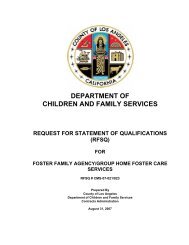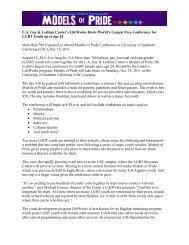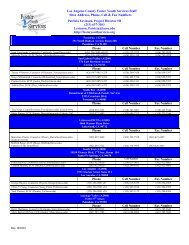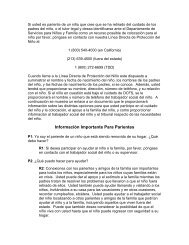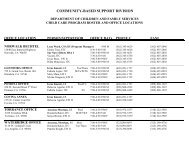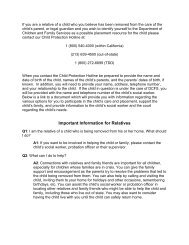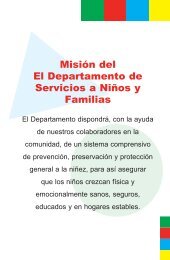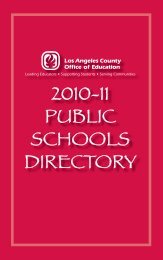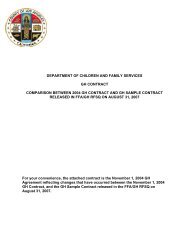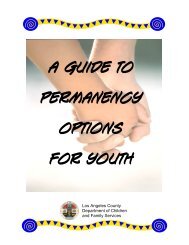Phases and Activities of the Wraparound Process - Los Angeles ...
Phases and Activities of the Wraparound Process - Los Angeles ...
Phases and Activities of the Wraparound Process - Los Angeles ...
You also want an ePaper? Increase the reach of your titles
YUMPU automatically turns print PDFs into web optimized ePapers that Google loves.
<strong>Phases</strong> <strong>and</strong> activities <strong>of</strong> <strong>the</strong> wraparound process 14<br />
<strong>Phases</strong> <strong>and</strong> <strong>Activities</strong> <strong>of</strong> <strong>the</strong> <strong>Wraparound</strong> <strong>Process</strong>: Phase 4<br />
MAJOR TASKS/Goals ACTIVITIES NOTES<br />
PHASE 4: Transition<br />
During this phase, plans are made for a purposeful transition out <strong>of</strong> formal wraparound to a mix <strong>of</strong> formal <strong>and</strong> natural supports in <strong>the</strong> community (<strong>and</strong>, if<br />
appropriate, to services <strong>and</strong> supports in <strong>the</strong> adult system). The focus on transition is continual during <strong>the</strong> wraparound process, <strong>and</strong> <strong>the</strong> preparation for<br />
transition is apparent even during <strong>the</strong> initial engagement activities.<br />
4.1. Plan for cessation <strong>of</strong> formal<br />
wraparound<br />
GOAL: To plan a purposeful<br />
transition out <strong>of</strong> formal<br />
wraparound in a way that is<br />
consistent with <strong>the</strong> wraparound<br />
principles, <strong>and</strong> that supports <strong>the</strong><br />
youth <strong>and</strong> family in maintaining<br />
<strong>the</strong> positive outcomes achieved in<br />
<strong>the</strong> wraparound process.<br />
4.1 a. Create a transition plan<br />
Facilitator guides <strong>the</strong> team in focusing on <strong>the</strong> transition<br />
from wraparound, reviewing strengths <strong>and</strong> needs <strong>and</strong><br />
identifying services <strong>and</strong> supports to meet needs that will<br />
persist past formal wraparound.<br />
4.1 b. Create a post-transition crisis management plan<br />
Facilitator guides <strong>the</strong> team in creating post-wraparound<br />
crisis management plan that includes action steps,<br />
specific responsibilities, <strong>and</strong> communication protocols.<br />
Planning may include rehearsing responses to crises <strong>and</strong><br />
creating linkage to post-wraparound crisis resources.<br />
4.1 c. Modify wraparound process to reflect transition<br />
New members may be added to <strong>the</strong> team to reflect<br />
identified post-transition strategies, services, <strong>and</strong><br />
supports. The team discusses responses to potential<br />
future situations, including crises, <strong>and</strong> negotiates <strong>the</strong><br />
nature <strong>of</strong> each team member’s post-wraparound<br />
participation with <strong>the</strong> team/family. Formal wraparound<br />
team meetings reduce frequency <strong>and</strong> ultimately cease.<br />
A Product <strong>of</strong> <strong>the</strong> National <strong>Wraparound</strong> Initiative – October 10, 2004 version<br />
Preparation for transition begins early in <strong>the</strong><br />
wraparound process, but intensifies as team meets<br />
needs <strong>and</strong> moves towards achieving <strong>the</strong> mission. While<br />
formal supports <strong>and</strong> services may be needed posttransition,<br />
<strong>the</strong> team is attentive to <strong>the</strong> need for<br />
developing a sustainable system <strong>of</strong> supports that is not<br />
dependent on formal wraparound. Teams may decide<br />
to continue wraparound—or a variation <strong>of</strong><br />
wraparound—even after it is no longer being provided<br />
as a formal service.<br />
At this point in transition, youth <strong>and</strong> family members,<br />
toge<strong>the</strong>r with <strong>the</strong>ir continuing supports, should have<br />
acquired skills <strong>and</strong> knowledge in how to manage<br />
crises. Post-transition crisis management planning<br />
should acknowledge <strong>and</strong> capitalize on this increased<br />
knowledge <strong>and</strong> streng<strong>the</strong>ned support system. This<br />
activity will likely include identification <strong>of</strong> access points<br />
<strong>and</strong> entitlements for formal services that may be used<br />
following formal wraparound.<br />
Teams may continue to meet using a wraparound<br />
process (or o<strong>the</strong>r process or format) even after formal<br />
wraparound has ended. Should teamwork continue,<br />
family members <strong>and</strong> youth, or o<strong>the</strong>r supports, will likely<br />
take on some or all <strong>of</strong> <strong>the</strong> facilitation <strong>and</strong> coordination<br />
activities.



